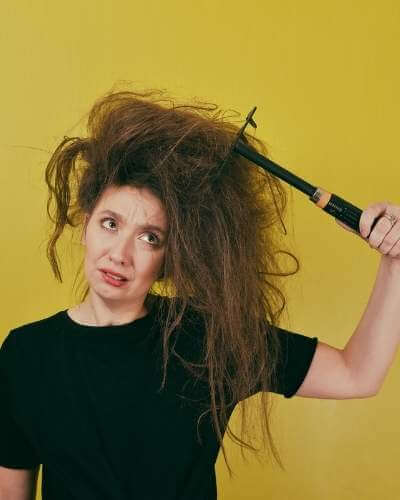Whether your hair is naturally poofy or has become poofy as a consequence of hair color or bleach, there is always a fix. we will share our top 5 tips to manage poofy Hair and smooth your hair.
Table of Contents
Difference between Poofy and Fluffy Hair
People frequently use the terms fluffy hair and poofy hair interchangeably, but there are several significant distinctions to be aware of. To begin with, fluffy hair is seen to be a nice balance between a sloppy texture and a blowout. So, while your strands are smooth, glossy, and bouncy, they have some thickness for a balanced look.
Poofy hair, on the other hand, is defined as hair that has a lot of volumes and a frizzy look. Humidity is a typical occurrence for people with thick and coily textured hair, and it is the major cause of poofy hair. While you may get fluffy hair by utilizing various hair care and style procedures, poofy hair is a natural result of the state of your strands.
What Causes Poofy Hair?

Despite the fact that poofy hair has a lot of volumes, not many are very fond of it. It’s possible that taming the frizz may become a never-ending battle.
Let us start by checking some scientific facts about poofiness. When our hair’s outer covering of tiny scales is flat and securely closed, it appears smooth and glossy. Once our hair is dry, even little humidity causes the hair scales to open, as the hair craves moisture. As the hairs slowly absorb moisture from the atmosphere, the outer side of the cuticle bristles up and expands, resulting in frizz. Hair with severely damaged cuticle elevated because of adverse impacts other than impacted by drying is another scenario. Lack of moisture and hair damage, frequently go together, feeding off of one another.
Combing our hair vigorously or tying them up in tight ponytails might create poofy hair, as we are really damaging the cuticle, leaving the hair without its protective covering.
Nutrition is important, and if a person does not take adequate nutrients to grow nutritious hair from the inside out, she risks developing dry, weak, and puffy hair.
When you use shampoo too frequently and don’t tailor your hair care regimen to the type of hair and scalp you have, you may easily deplete it with natural oil, resulting in puffiness.
Top 5 Tips to Manage Poofy Hair
Shampoo in Moderation
You may believe that shampooing your hair multiple times a week is necessary, but it is not, especially if you have poofy hair. Wash your thick poofy hair no more than twice a week, and use moisturizing products made particularly for dry and damaged hair. Avoid using products that include sulfates, which can cause your hair to become dry and frizzy. After shampooing, you should use a conditioner, although leave-in treatments will help you get rid of frizz faster.
Natural products are the best for your hair; working with nature rather than against it is the most efficient method to give your hair the nutrients it requires.
You’ll soon see your hair in all its beauty, just as nature intended if you use high-end products with organic components.
Protect your Hair
UV rays cause the cuticle to break down, leaving your hair dry, damaged, and frizzy. Hair is similar to a lovely piece of fruit. Just like the fruit, it has an outer skin to protect it, similar to the hair’s cuticle. When the outside of either is damaged, the interior begins to deteriorate.
The sun’s rays have a bleach-like effect on hair. UVB causes the pigment cells in your hair to oxidize, which is why your hair turns paler in the sun.
Heat protectants, SPF sprays, and wearing a swimming hat or headgear in the pool are all options for sun protection.
Reduce friction

The cuticle is disrupted by vigorously rubbing a towel across your hair. To avoid friction frizz, consider drying your hair in a towel turban. You may also minimise friction by switching to a silk pillowcase instead of a cotton one. By switching to a silk pillowcase, your hair cuticles slide across the pillowcase rather than being snagged by it thanks to the slick fabric.
Pull your hair back into loose buns if you wash at night or merely want to have a flawless blowout for second-day hair. This avoids morning tangles by keeping your hair from moving around while you toss and turn. When it’s time to brush your hair, use a wide-toothed comb instead of your regular brush. Because there are fewer bristles, there is less friction on your hair and less damage from pulling heavy knots through rows of bristles.
Take into account that while your hair is damp, it is at its most delicate. That implies that the improper towel can actually make or break your hair, emphasizing the importance of fabric selection. Breakage and frizz are caused by friction between cotton towels and your hair.
Microfiber towels, on the other hand, are constructed of man-made strands that are only a single micron thick. A microfiber towel of just one square inch has a huge and absorbent surface with over 200,000 fibres, which is about 100 times finer than a strand of human hair.
Microfiber is a soft and silky texture, so you don’t have to exert as much effort or friction to dry your hair quickly. Your hair will be dry but not too so, allowing it to retain its smoothness and manageability.
Microfiber towels also keep your hair cuticles smooth and flat, reducing the amount of frizz-controlling treatments you need to use.
Proper Moisturizing

Frizz is generally caused by a lack of moisture in the hair, however, it may be a component of certain people’s DNA. When your hair is dry, damaged, or chemically treated, the outer layer of the strand rises rather than resting flat and smooth, enabling moisture from the surrounding air to enter and cause it to swell and frizz. The more moisturized your hair is, the more the cuticle layer will lay flat, resulting in silky, flyaway-free strands.
A good hair mask that is high in nutrients and moisturizers will strengthen the hair strands, control the poof and cuticles will become smoother.
As a hydration boost, you should use a deep conditioning mask at least once a week. A good hair mask will not only hydrate your hair from the inside out, but it will also prevent it from things like heat damage and split ends, both of which may cause frizz.
Conditioning and strengthening your hair with a hot oil treatment is also a fantastic idea. To help reinforce the cuticle and prevent frizz, try a treatment with jojoba oil. For the best result, before you massage your hair and scalp, consider mildly warming the oil.
Check Top 10 Professional Hair Care Brands and Products of 2021
Haircut matters
Remove any dry, hair dead ends. Split ends may cause further damage and frizz as they go up the strand, so get a trim as soon as you see fraying. If you reside in an area with a lot of humidity. This keeps the haircut weighted, which helps hold the hair down.
Short styles like bobs and shags, as adorable as they are, just don’t work with frizzy hair. Blunt haircuts are also a terrible idea since they cause your hair to puff out at the bottom, making it seem frizzy and damaged. Puffiness is further accentuated by heavily layered cuts.
For frizzy and dry hair, long cuts and medium-lengths are ideal. By dragging strands down, long hair reduces frizz and minimizes poofiness. You can also reduce the fizziness of your hair in a similar method are to adept to the hair cut with a medium length that falls a few inches under the shoulders. To create movement and structure to your hair, apply a few delicate, face-framing layers below the chin.
Allow your wavy hair to grow out as much as you like, but make sure it’s at least 2 to 3 inches past your shoulders to keep strands from frizzing. Instead of cutting your hair straight across, have your hairdresser trim the ends at a little slant. Curly hair is defined by light layers cut throughout the hair.
Summary
Hair that is dry poofy and frizzy, cannot be repaired overnight. Reduce frizz and restore moisture to parched strands may take months or even years of adequate maintenance. Reduce friction by getting a good haircut and conditioning your hair every day, but only shampooing occasionally. Limit hair washing to twice a week or less to avoid stripping it of natural moisturizing oils generated in the scalp. At least once in 2 days, practice a leave-in conditioner, and once a month, use hot oil treatment or deep conditioning. Use a detangling brush, soft elastics to protect your strands from harm, and avoid touching and combing your hair when it’s damp.
Perhaps, we’ve persuaded you that puffy hair can be managed with the right method.

Creative, versatile, and passionate about her craft, Rupa Das is a well-recognized name in the world of fashion and makeup! This is a woman who has been in the fashion and makeup industry for 24 years and is still one of the leading international makeup artist in the circuit! She has worked in big brands like Lakme, Green Trends, Colors and transitioned to become a Beauty (Hair & Skin) Trainer.